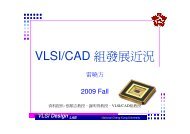Wind power
Wind power
Wind power
You also want an ePaper? Increase the reach of your titles
YUMPU automatically turns print PDFs into web optimized ePapers that Google loves.
<strong>Wind</strong> Power<br />
• <strong>Wind</strong> energy conversion systems convert<br />
the kinetic energy of a renewable resource<br />
-wind- to mechanical energy.<br />
• <strong>Wind</strong>mills have been used for centuries to<br />
pump water and grind grain, and more<br />
recently to generate electricity.<br />
• Small systems (from a fraction of a W, to<br />
several kW <strong>power</strong> rating) are frequently<br />
used as part of remote area <strong>power</strong> supplies,<br />
and larger systems (50 - 2MW) have been<br />
integrated with the main <strong>power</strong> grid in<br />
several countries inlcluding the US and<br />
most abundantly, in Australia.<br />
http://www.greenhouse.gov.au/renewable/technologies/wind/index.html#<strong>Wind</strong>Use
<strong>Wind</strong> Power<br />
• <strong>Wind</strong> energy conversion systems convert<br />
the kinetic energy of a renewable resource<br />
-wind- to mechanical energy.<br />
• <strong>Wind</strong>mills have been used for centuries to<br />
pump water and grind grain, and more<br />
recently to generate electricity.<br />
• Small systems (from a fraction of a W, to<br />
several kW <strong>power</strong> rating) are frequently<br />
used as part of remote area <strong>power</strong> supplies,<br />
and larger systems (50 - 2MW) have been<br />
integrated with the main <strong>power</strong> grid in<br />
several countries inlcluding the US and<br />
most abundantly, in Australia.<br />
http://www.greenhouse.gov.au/renewable/technologies/wind/index.html#<strong>Wind</strong>Use
<strong>Wind</strong> Power<br />
• <strong>Wind</strong> energy conversion systems convert<br />
the kinetic energy of a renewable resource<br />
-wind- to mechanical energy.<br />
• <strong>Wind</strong>mills have been used for centuries to<br />
pump water and grind grain, and more<br />
recently to generate electricity.<br />
• Small systems (from a fraction of a W, to<br />
several kW <strong>power</strong> rating) are frequently<br />
used as part of remote area <strong>power</strong> supplies,<br />
and larger systems (50 - 2MW) have been<br />
integrated with the main <strong>power</strong> grid in<br />
several countries inlcluding the US and<br />
most abundantly, in Australia.<br />
http://www.greenhouse.gov.au/renewable/technologies/wind/index.html#<strong>Wind</strong>Use
<strong>Wind</strong> Power<br />
• <strong>Wind</strong> energy conversion systems convert<br />
the kinetic energy of a renewable resource<br />
-wind- to mechanical energy.<br />
• <strong>Wind</strong>mills have been used for centuries to<br />
pump water and grind grain, and more<br />
recently to generate electricity.<br />
• Small systems (from a fraction of a W, to<br />
several kW <strong>power</strong> rating) are frequently<br />
used as part of remote area <strong>power</strong> supplies,<br />
and larger systems (50 - 2MW) have been<br />
integrated with the main <strong>power</strong> grid in<br />
several countries inlcluding the US and<br />
most abundantly, in Australia.<br />
http://www.greenhouse.gov.au/renewable/technologies/wind/index.html#<strong>Wind</strong>Use
<strong>Wind</strong> Power<br />
• <strong>Wind</strong> energy conversion systems convert<br />
the kinetic energy of a renewable resource<br />
-wind- to mechanical energy.<br />
• <strong>Wind</strong>mills have been used for centuries to<br />
pump water and grind grain, and more<br />
recently to generate electricity.<br />
• Small systems (from a fraction of a W, to<br />
several kW <strong>power</strong> rating) are frequently<br />
used as part of remote area <strong>power</strong> supplies,<br />
and larger systems (50 - 2MW) have been<br />
integrated with the main <strong>power</strong> grid in<br />
several countries inlcluding the US and<br />
most abundantly, in Australia.<br />
http://www.greenhouse.gov.au/renewable/technologies/wind/index.html#<strong>Wind</strong>Use
<strong>Wind</strong> Power<br />
• <strong>Wind</strong> energy conversion systems convert<br />
the kinetic energy of a renewable resource<br />
-wind- to mechanical energy.<br />
• <strong>Wind</strong>mills have been used for centuries to<br />
pump water and grind grain, and more<br />
recently to generate electricity.<br />
• Small systems (from a fraction of a W, to<br />
several kW <strong>power</strong> rating) are frequently<br />
used as part of remote area <strong>power</strong> supplies,<br />
and larger systems (50 - 2MW) have been<br />
integrated with the main <strong>power</strong> grid in<br />
several countries inlcluding the US and<br />
most abundantly, in Australia.<br />
http://www.greenhouse.gov.au/renewable/technologies/wind/index.html#<strong>Wind</strong>Use
<strong>Wind</strong> Power<br />
• <strong>Wind</strong> energy conversion systems convert<br />
the kinetic energy of a renewable resource<br />
-wind- to mechanical energy.<br />
• <strong>Wind</strong>mills have been used for centuries to<br />
pump water and grind grain, and more<br />
recently to generate electricity.<br />
• Small systems (from a fraction of a W, to<br />
several kW <strong>power</strong> rating) are frequently<br />
used as part of remote area <strong>power</strong> supplies,<br />
and larger systems (50 - 2MW) have been<br />
integrated with the main <strong>power</strong> grid in<br />
several countries inlcluding the US and<br />
most abundantly, in Australia.<br />
http://www.greenhouse.gov.au/renewable/technologies/wind/index.html#<strong>Wind</strong>Use
<strong>Wind</strong> Power<br />
• <strong>Wind</strong> energy conversion systems convert<br />
the kinetic energy of a renewable resource<br />
-wind- to mechanical energy.<br />
• <strong>Wind</strong>mills have been used for centuries to<br />
pump water and grind grain, and more<br />
recently to generate electricity.<br />
• Small systems (from a fraction of a W, to<br />
several kW <strong>power</strong> rating) are frequently<br />
used as part of remote area <strong>power</strong> supplies,<br />
and larger systems (50 - 2MW) have been<br />
integrated with the main <strong>power</strong> grid in<br />
several countries inlcluding the US and<br />
most abundantly, in Australia.<br />
http://www.greenhouse.gov.au/renewable/technologies/wind/index.html#<strong>Wind</strong>Use
<strong>Wind</strong> Power<br />
• <strong>Wind</strong> energy conversion systems convert<br />
the kinetic energy of a renewable resource<br />
-wind- to mechanical energy.<br />
• <strong>Wind</strong>mills have been used for centuries to<br />
pump water and grind grain, and more<br />
recently to generate electricity.<br />
• Small systems (from a fraction of a W, to<br />
several kW <strong>power</strong> rating) are frequently<br />
used as part of remote area <strong>power</strong> supplies,<br />
and larger systems (50 - 2MW) have been<br />
integrated with the main <strong>power</strong> grid in<br />
several countries inlcluding the US and<br />
most abundantly, in Australia.<br />
http://www.greenhouse.gov.au/renewable/technologies/wind/index.html#<strong>Wind</strong>Use
<strong>Wind</strong> Power<br />
• <strong>Wind</strong> energy conversion systems convert<br />
the kinetic energy of a renewable resource<br />
-wind- to mechanical energy.<br />
• <strong>Wind</strong>mills have been used for centuries to<br />
pump water and grind grain, and more<br />
recently to generate electricity.<br />
• Small systems (from a fraction of a W, to<br />
several kW <strong>power</strong> rating) are frequently<br />
used as part of remote area <strong>power</strong> supplies,<br />
and larger systems (50 - 2MW) have been<br />
integrated with the main <strong>power</strong> grid in<br />
several countries inlcluding the US and<br />
most abundantly, in Australia.<br />
http://www.greenhouse.gov.au/renewable/technologies/wind/index.html#<strong>Wind</strong>Use
<strong>Wind</strong> Power<br />
• <strong>Wind</strong> energy conversion systems convert<br />
the kinetic energy of a renewable resource<br />
-wind- to mechanical energy.<br />
• <strong>Wind</strong>mills have been used for centuries to<br />
pump water and grind grain, and more<br />
recently to generate electricity.<br />
• Small systems (from a fraction of a W, to<br />
several kW <strong>power</strong> rating) are frequently<br />
used as part of remote area <strong>power</strong> supplies,<br />
and larger systems (50 - 2MW) have been<br />
integrated with the main <strong>power</strong> grid in<br />
several countries inlcluding the US and<br />
most abundantly, in Australia.<br />
http://www.greenhouse.gov.au/renewable/technologies/wind/index.html#<strong>Wind</strong>Use
¦©<br />
¦<br />
©<br />
<br />
¨<br />
¢¡<br />
£<br />
¥¤<br />
¤<br />
¨<br />
¦<br />
¦©<br />
£<br />
¦©<br />
<br />
<br />
£<br />
¢¡<br />
¨<br />
¤<br />
¨<br />
£<br />
¦<br />
£<br />
<br />
¦ ¡<br />
<br />
<br />
¥<br />
§<br />
¨<br />
¦ ¥<br />
¦<br />
©<br />
£<br />
©<br />
<br />
<br />
<br />
<br />
<br />
©<br />
¦<br />
¨<br />
©<br />
¦<br />
¦<br />
©<br />
¦<br />
©<br />
©<br />
©<br />
£<br />
©<br />
¥<br />
©<br />
¤<br />
©<br />
§<br />
©<br />
<br />
©<br />
¨<br />
©<br />
¦<br />
£ ©<br />
¦<br />
<br />
<br />
<br />
<br />
¦ ¡<br />
§<br />
¦ ¡<br />
¨<br />
¢¡<br />
©<br />
£<br />
¢¡<br />
<br />
<br />
¢¡<br />
¦<br />
¦<br />
¨<br />
¥<br />
¢¡<br />
¢¡<br />
§¦<br />
<br />
¢¡<br />
<br />
¦©<br />
¢¡<br />
¥<br />
¢¡<br />
¥<br />
¦<br />
¢¡<br />
<br />
¤<br />
¢¡<br />
¦©<br />
¥<br />
¦ ¡<br />
<br />
£<br />
<br />
<br />
<br />
<br />
¦©<br />
¥<br />
¦©<br />
¤<br />
¦©<br />
§<br />
¦©<br />
<br />
¦©<br />
¨<br />
¦©<br />
¦<br />
©<br />
¦<br />
¨<br />
©<br />
¦<br />
¦<br />
©<br />
¦<br />
©<br />
©<br />
©<br />
£<br />
<br />
<br />
<br />
<br />
<br />
<br />
¢¡<br />
§<br />
¢¡<br />
¦¨<br />
¢¡<br />
§¨<br />
¢¡<br />
¤<br />
<br />
¢¡<br />
¥<br />
©£<br />
¢¡<br />
§©<br />
¦ ¡<br />
¦<br />
¦ ¡<br />
¦ ¥<br />
¦ ¡<br />
¢¡<br />
<br />
§<br />
¢¡
¦©<br />
¦<br />
©<br />
<br />
¨<br />
¢¡<br />
£<br />
¥¤<br />
¤<br />
¨<br />
¦<br />
¦©<br />
£<br />
¦©<br />
<br />
<br />
£<br />
¢¡<br />
¨<br />
¤<br />
¨<br />
£<br />
¦<br />
£<br />
<br />
¦ ¡<br />
<br />
<br />
¥<br />
§<br />
¨<br />
¦ ¥<br />
¦<br />
©<br />
£<br />
©<br />
<br />
<br />
<br />
<br />
<br />
©<br />
¦<br />
¨<br />
©<br />
¦<br />
¦<br />
©<br />
¦<br />
©<br />
©<br />
©<br />
£<br />
©<br />
¥<br />
©<br />
¤<br />
©<br />
§<br />
©<br />
<br />
©<br />
¨<br />
©<br />
¦<br />
£ ©<br />
¦<br />
<br />
<br />
<br />
<br />
¦ ¡<br />
§<br />
¦ ¡<br />
¨<br />
¢¡<br />
©<br />
£<br />
¢¡<br />
<br />
<br />
¢¡<br />
¦<br />
¦<br />
¨<br />
¥<br />
¢¡<br />
¢¡<br />
§¦<br />
<br />
¢¡<br />
<br />
¦©<br />
¢¡<br />
¥<br />
¢¡<br />
¥<br />
¦<br />
¢¡<br />
<br />
¤<br />
¢¡<br />
¦©<br />
¥<br />
¦ ¡<br />
<br />
£<br />
<br />
<br />
<br />
<br />
¦©<br />
¥<br />
¦©<br />
¤<br />
¦©<br />
§<br />
¦©<br />
<br />
¦©<br />
¨<br />
¦©<br />
¦<br />
©<br />
¦<br />
¨<br />
©<br />
¦<br />
¦<br />
©<br />
¦<br />
©<br />
©<br />
©<br />
£<br />
<br />
<br />
<br />
<br />
<br />
<br />
¢¡<br />
§<br />
¢¡<br />
¦¨<br />
¢¡<br />
§¨<br />
¢¡<br />
¤<br />
<br />
¢¡<br />
¥<br />
©£<br />
¢¡<br />
§©<br />
¦ ¡<br />
¦<br />
¦ ¡<br />
¦ ¥<br />
¦ ¡<br />
¢¡<br />
<br />
§<br />
¢¡
¦©<br />
¦<br />
©<br />
<br />
¨<br />
¢¡<br />
£<br />
¥¤<br />
¤<br />
¨<br />
¦<br />
¦©<br />
£<br />
¦©<br />
<br />
<br />
£<br />
¢¡<br />
¨<br />
¤<br />
¨<br />
£<br />
¦<br />
£<br />
<br />
¦ ¡<br />
<br />
<br />
¥<br />
§<br />
¨<br />
¦ ¥<br />
¦<br />
©<br />
£<br />
©<br />
<br />
<br />
<br />
<br />
<br />
©<br />
¦<br />
¨<br />
©<br />
¦<br />
¦<br />
©<br />
¦<br />
©<br />
©<br />
©<br />
£<br />
©<br />
¥<br />
©<br />
¤<br />
©<br />
§<br />
©<br />
<br />
©<br />
¨<br />
©<br />
¦<br />
£ ©<br />
¦<br />
<br />
<br />
<br />
<br />
¦ ¡<br />
§<br />
¦ ¡<br />
¨<br />
¢¡<br />
©<br />
£<br />
¢¡<br />
<br />
<br />
¢¡<br />
¦<br />
¦<br />
¨<br />
¥<br />
¢¡<br />
¢¡<br />
§¦<br />
<br />
¢¡<br />
<br />
¦©<br />
¢¡<br />
¥<br />
¢¡<br />
¥<br />
¦<br />
¢¡<br />
<br />
¤<br />
¢¡<br />
¦©<br />
¥<br />
¦ ¡<br />
<br />
£<br />
<br />
<br />
<br />
<br />
¦©<br />
¥<br />
¦©<br />
¤<br />
¦©<br />
§<br />
¦©<br />
<br />
¦©<br />
¨<br />
¦©<br />
¦<br />
©<br />
¦<br />
¨<br />
©<br />
¦<br />
¦<br />
©<br />
¦<br />
©<br />
©<br />
©<br />
£<br />
<br />
<br />
<br />
<br />
<br />
<br />
¢¡<br />
§<br />
¢¡<br />
¦¨<br />
¢¡<br />
§¨<br />
¢¡<br />
¤<br />
<br />
¢¡<br />
¥<br />
©£<br />
¢¡<br />
§©<br />
¦ ¡<br />
¦<br />
¦ ¡<br />
¦ ¥<br />
¦ ¡<br />
¢¡<br />
<br />
§<br />
¢¡
5m/s
5m/s
• 11 7.3 <br />
8 3.2 <br />
• 11 11.9 <br />
4 7.9 <br />
• 3
• 11 7.3 <br />
8 3.2 <br />
• 11 11.9 <br />
4 7.9 <br />
• 3
• 11 7.3 <br />
8 3.2 <br />
• 11 11.9 <br />
4 7.9 <br />
• 3
Components of a large scale wind<br />
generator
Large and Small Scale Turbines<br />
For utility-scale sources of energy,<br />
many turbines are built to form<br />
a wind plant<br />
Individual turbines help pump<br />
water from underground bores
Large and Small Scale Turbines<br />
For utility-scale sources of energy,<br />
many turbines are built to form<br />
a wind plant<br />
Individual turbines help pump<br />
water from underground bores
Large and Small Scale Turbines<br />
For utility-scale sources of energy,<br />
many turbines are built to form<br />
a wind plant<br />
Individual turbines help pump<br />
water from underground bores
Bernoulli Relation ((<br />
)<br />
P<br />
1<br />
+<br />
1 2<br />
1 2<br />
ρ V1<br />
+ ρgZ1<br />
= P2<br />
+ ρV2<br />
+<br />
2<br />
2<br />
ρgZ<br />
2<br />
P: ; V: ; : <br />
; g: ; z: <br />
1 2
Bernoulli Relation ((<br />
)<br />
P<br />
1<br />
+<br />
1 2<br />
1 2<br />
ρ V1<br />
+ ρgZ1<br />
= P2<br />
+ ρV2<br />
+<br />
2<br />
2<br />
ρgZ<br />
2<br />
P: ; V: ; : <br />
; g: ; z: <br />
1 2
Bernoulli Relation ((<br />
)<br />
P<br />
1<br />
+<br />
1 2<br />
1 2<br />
ρ V1<br />
+ ρgZ1<br />
= P2<br />
+ ρV2<br />
+<br />
2<br />
2<br />
ρgZ<br />
2<br />
P: ; V: ; : <br />
; g: ; z: <br />
1 2
Important Considerations<br />
• Site evaluation<br />
– Average wind speed is the critical factor used in<br />
determining the economic effectiveness of wind machines.<br />
– The amount of <strong>power</strong> available in the wind is proportional<br />
to the cube of the wind speed.<br />
– An anemometer is used to measure wind speed.<br />
– Government weather stations in your area can provide<br />
average monthly wind speed figures for a whole year.<br />
– You need to know the highest wind speed gusts that are<br />
likely at your site.<br />
– Your wind generator and tower support must be designed<br />
to handle this amount of gusting for safety and insurance<br />
purposes.
• Equipment<br />
Important Considerations<br />
– Combine the efficiencies of both rotor and generator to<br />
determine system efficiency .<br />
– Today’s best turbines can convert about 40% of the wind<br />
energy to mechanical energy.<br />
– With a typical generator efficiency of about 85%, the wind<br />
energy conversion system (WECS) can achieve a maximum<br />
overall efficiency of about 35%.<br />
– Higher altitudes have lower air density and require higher<br />
wind speeds to achieve a given output.
Important Considerations<br />
• System Sizing<br />
– The amount of electricity required is the basis for deciding<br />
the size wind generator you need.<br />
– Power requirements may change during the year, so the<br />
demand estimate should be made on a monthly and<br />
seasonal basis.<br />
– Decide what appliances will be used and how long they<br />
will be turned on to determine demand estimates<br />
– Also determine the maximum rate of electricity required, or<br />
how many electrical devices will be on at the same time.
Important Considerations<br />
• Proper Tower Placement<br />
– <strong>Wind</strong> turbine location is very important.<br />
– <strong>Wind</strong> speed can vary 30% or more between<br />
sites only 100 feet apart of rolling hills or<br />
tree cover.<br />
– The wind turbine should be mounted on a<br />
tower 30 to 80 feet high to take maximum<br />
advantage of the wind.<br />
– The rule of thumb is to have the tower<br />
height at least 20 feet higher than any<br />
potential obstacle within a range of 500 feet.<br />
– An increase of only 1 mph wind speed can<br />
give a 33% increase in <strong>power</strong>.
Important Considerations<br />
• Energy Conservation<br />
– Tower and foundation costs can be significant.<br />
– A large battery bank will allow for longer periods<br />
of low wind without the need of a back-up system.<br />
– An inverter allows you to convert wind <strong>power</strong> to<br />
AC and use more conventional appliances and<br />
wiring. Weigh the expense of the inverter versus<br />
efficiency, possibility of both AC and DC circuits,<br />
and appliances involved.
2005 58,214MW<br />
2001-2005 39,765MW<br />
28,230MW <br />
71% <br />
2020 <br />
12 <br />
2.5-3











